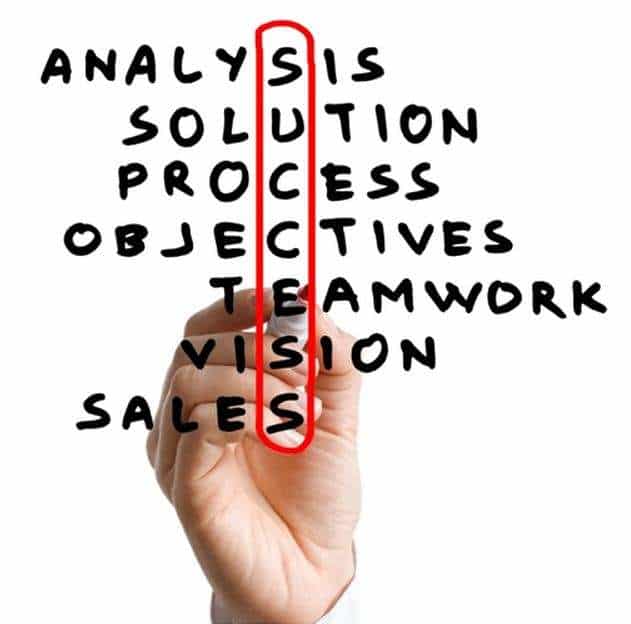Making Your Sales Process…Work

Ask yourself if this sounds familiar.
You ask one of your employees or team members about an opportunity with a potential new customer.
“Looks good,” he says.
“Why’s that?” you ask.

“They liked what we had to show them. I feel good about it.”
You ask, “What’s the next step?”
“I’m waiting to hear back.”
A little uncertain as if there’s anything really there, you go to another person responsible for bringing in new business to ask her about a deal.
“What’s the latest on XYZ?” you ask. “I know that one was supposed to close by the end of the quarter, and we have 2 weeks left.”
“We have to get a meeting with their legal department…” she replies.
“But we have to sign off from the c-suite, right?” you ask.
“Our champion really likes us.”
“That’s not what I asked. Have we gotten a sign off from someone with a C in their title?” you press.
“Not exactly.”
And that’s one symptom of a broken sales process.
Or one that’s not staged appropriately.
Or one that’s not really managed to.
Or one that doesn’t exist.
Leading many CEOs to lay awake at night wondering what they need to do to hit their revenue targets.
Is this your organization?
And if it is your organization, what can you do?
________________________________________________________________________________________________________________
Let’s define a sales process. And not according to ChatGPT.
It’s a series of stages designed to qualify a potential customer. Each stage has a set of milestones that need to be met in order to qualify the opportunity.
A stage might be something like “Qualified,” and a milestone could be something like, “We know who our competition is.”
In practice, this should be very simple and straightforward.
In reality, most are heavily over-engineered (because most are pulling from the same source materials).
I talked to a friend the other day about a 17 step sales process.
17. I have 4 kids and I get their names and birthdates confused.
17 is too many points of failure. Frankly, anything over 5 or 6 is too many points of failure.
8 or 10 or 15 or 20 steps is also really common. Why? Companies love to bring in some massive process because it exudes sophistication.
In Shane Parrish’s Clear Thinking, he says, “Most people chase complexity…They learn the basics enough to be average, then look for the secret, shortcut, or hidden knowledge. Mastering the basics is the key to being ruthlessly effective. The basics might seem simple but that doesn’t mean they’re simplistic.”
The result of chasing this complexity? Most people selling aren’t very good at fundamentals. Seeking to prove ROI, or the technical case, they never actually uncover what’s most compelling or important to the senior person they’re talking to.
I strongly advocate simple processes, no more than 6 steps. I learned this from Dave Kurlan, and have seen it work in everything from small business to enterprise sales teams.
I’m also a fan of, wait for it…

following the process. Across reps. And managers actually coaching the process.
But why?
________________________________________________________________________________________________________________
If a process is broken, or isn’t staged appropriately….
… you get reps chasing deals that supposedly were closed 2 weeks ago, offering unilateral concessions. Not ideal for margin. Or renewals.
If a process isn’t followed uniformly across the sales or biz dev teams…
… you don’t have a roll up of a pipeline: you have a series of pipelines that all have different definitions. Neither the CFO nor the board like that lack of clarity.
If a process isn’t coached to…
… you don’t know why deals are lost, or what needs to happen when one stalls out. A solid process – enforced – tells you what’s missing.

However, if you’ve got one…
… you are able to identify what information you need (but don’t have) to determine if a deal will close.
… you know where deals that are lost went wrong.
… you are able to improve forecasting every quarter by reviewing the process and the deals in it.
And that helps you win business AND sleep at night.
So what can you do?
________________________________________________________________________________________________________________
It’s not rocket science.

- Ask yourself, “What do we want to know from a potential customer?” Make a list of questions. Your list should include items like, “Do they have money? Do they have a problem? Do they want to solve it?”
- Then look at the list, and ask yourself, “What assumptions am I making?” For example, we typically assume that a company taking a meeting and wanting another is indicating several other facts: they want it; they need it; they will spend money. Nope. Line out your assumptions.
- Turn every assumption into a question that becomes part of your list.
- Bundle your list of questions by topic: those related to initial interest, those dealing with the business issues, those about specs or technical elements, other regarding decision making or money, legal, etc… These questions become your milestones.
- Create stages that follow the progression of a romantic relationship, where we move from surface discussions (is there a reason to talk?) to substantive issues (what’s at stake for your business?) to sorting out the details of how a long-term relationship would work (how do you make decisions about a vendor? What works financially?).
- As a rule of thumb, there should be no more than 4-6 stages, from initial contact to closed deal.
- Review the milestones you want in each stage. They should be stage-appropriate. For instance, you’re typically not asking about money in the early stages for several reasons: price doesn’t matter if there’s not a desire to invest; budgets are often fluid based on the nature of the purchase; you’re likely not dealing with all of the right people at the time.
- Review this process against several deals, both those you’ve lost and those you’ve won. Would this flow of stages and milestones work in a sales process? Would it prevent late-stage discounting? Would it tell you if you were going to win or lose?
- Bake it into your CRM. These stages are non-negotiable, and the milestones are those your people need to be touching.
- Your managers (and you, if you’re the manager or an exec) need to be coaching them to hit these milestones.
- Eventually, you want to tie percentages to each stage that are predictive of outcomes. For instance, if a stage reads, “40%,” meaning, if a stage should say a deal is at 40% to close, look at historical data and ask, “What percentage of these deals close?” It better be 40%.
- If all that fails, ping me or someone like Dave Kurlan or Aaron Prickel at Lushin. We’ll get you sorted.
How’s that for a plan?

________________________________________________________________________________________________________________
If you’re running a company or a sales organization, your process should be predictive of outcomes.
It should tell you what information you need next.
Your people, following the same process, should see consistently improving results.
And you, when you look at your forecast, should breathe a little easier. Because you believe the pipeline.. And are seeing the results in your financials.
Want to review your process? Or simply rebuild it? You can reach me at
adam@thenorthwoodgrp.com.

